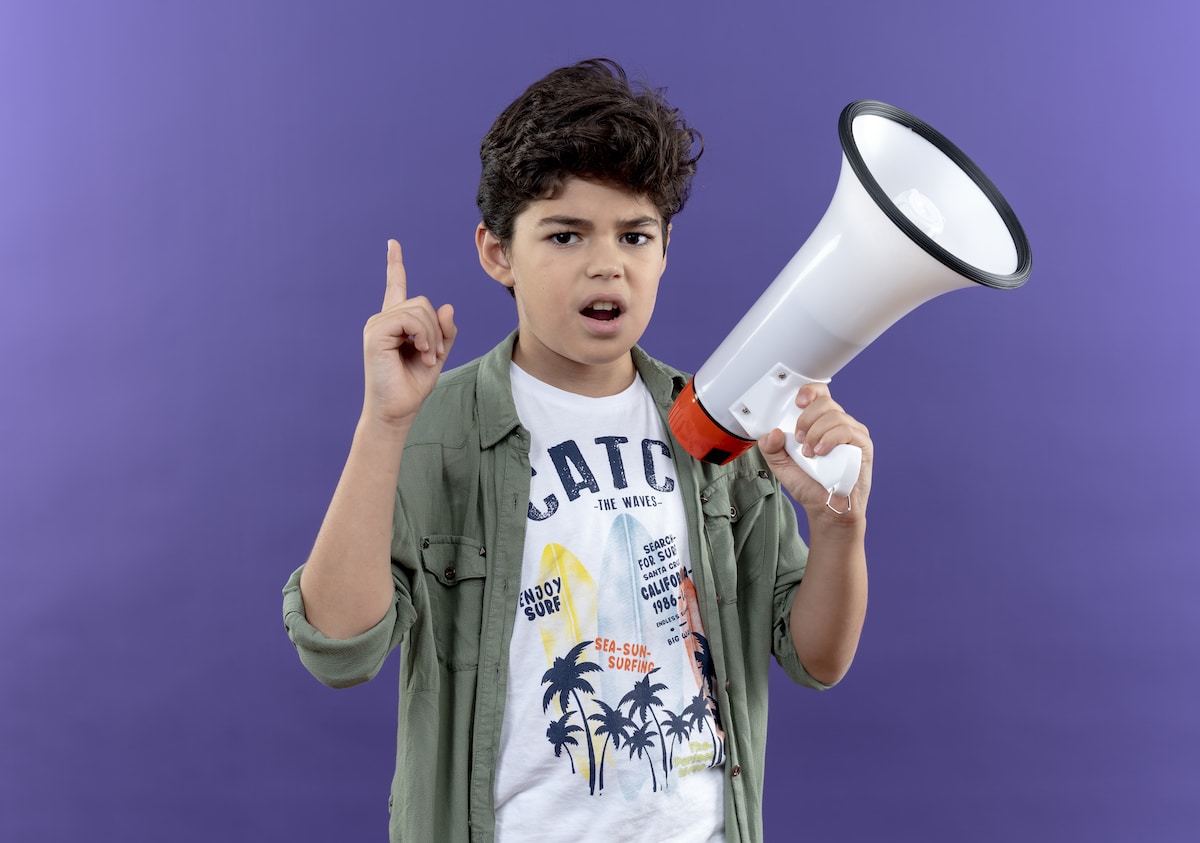You’ve tried different ways to discover how to get your child to stop talking back. Yelling, taking away their things, ignoring them, and even letting them have the last word. However, these methods have only made things worse. It’s tiring and damaging to your relationship.
So, how do you discipline a child who always talks back? Is there an appropriate punishment for talking back? How can you make them listen? How do you break this cycle of negative behavior?
Backtalk is a common issue parents and individuals working with children are facing constantly. It can be difficult to determine the best course of action.
Different methods are popping up in your mind when wondering how to get your child to stop talking back. Should you walk away and ignore it or should you address it with firm consequences?
Some think that children talk back in the heat of the moment and will grow out of it. Others believe that it creates a negative pattern for social interactions. This article aims to provide insights into how to improve adult-child interactions and effectively address backtalk.
Why children talk back
Even a 5-year-old talking back to parents and other family members is a solid entry on the list of bad behavior. However, you need to understand when researching how to get your child to stop talking back that this isn’t always a sign of disrespect or defiance.
Why is talking back disrespectful? We all want our children to make wise decisions. When they comply with our advice, we feel that we’re guiding them correctly. However, kids talking back make us feel the opposite of reassured.
On the other hand, it’s common for children to feel like they’re not being heard or taken seriously. This can lead to frustration and a sense of helplessness. Children might talk back if they feel that their parents are dismissing their concerns or not giving them enough attention.
Similarly, if children feel that their efforts are not being recognized or appreciated, they may turn a simple notice or reminder coming from parents into an argument. Another common reason why children might talk back is that they are feeling criticized or unfavorably compared to their siblings or peers.
This is why it’s important to address the root cause first. Only after that can you see if your child’s behavior is intentionally disrespectful or a cry for help.
How to get your child to stop talking back
Learning how to get your child to stop talking back can be a challenging task. However, it’s not impossible. There are several strategies that parents can use to help reduce or eliminate rude behavior and backtalk.
👉Unlock the secrets of dealing with behavior problems with our article on “How to Discipline Your Child That Doesn’t Listen in the Smart and Healthy Way.” Discover proven techniques that foster cooperation, respect, and emotional development in your child.
1. Science-based Strategies for Managing Backtalk
Encourage dialogue and discussion

Why do kids talk back? The traditional approach to education and discipline leaves children with little room for open dialogue and debate. This makes them feel like they can’t express their thoughts and opinions freely. As a result, they may resort to backtalk as a way of asserting their voice and gaining a sense of control over their lives.
Parents can demonstrate that they value their children’s opinions and feelings by responding to backtalk with a willingness to have a productive, respectful conversation.
“Sure, let’s talk about it!”, used at least once in a day gets parents closer to removing backtalks from the family environment.
Model Respectful Communication
Children are constantly learning and taking in communication patterns, which they integrate as skills for their future interactions. To model acceptable ways of expressing thoughts, parents should communicate with respect and avoid negative language.
Negative language can include words or phrases that are critical, judgmental, or blaming. This type of language can shut down communication, create a confrontational atmosphere, and plant seeds for that unwanted backtalk.
So, what to do when kids talk back? For example, instead of saying “You always do this wrong,” a parent could say “I appreciate that you tried your best, now maybe we can work together to find a better solution.” This approach acknowledges the child’s effort while also providing an opportunity for improvement.
Teach problem-solving skills

So, how to get your child to stop talking back? This behavior often occurs when children feel frustrated or powerless and are seeking more guidance. Teaching problem-solving skills to children can be a valuable asset in reducing the occurrence of rude behavior and backtalks. This practice can involve modeling constructive behaviors, such as brainstorming and evaluating options.
Children who are responsible and independent are less likely to engage in backtalk as they feel empowered to make decisions and take action. For example, if a child is upset about not being allowed to go out with their friends, instead of talking back, they can use problem-solving skills to find a solution. They can think of alternatives, such as inviting friends over or reaching a compromise with their parents.
Set Clear Boundaries and Expectations
When boundaries are not clear, children may become confused or unsure about what is expected of them. Inconsistent enforcement of rules can also lead to frustration in children, which can make them resort to backtalk and other types of disrespectful behavior.
Having regular family meetings or a designated time for caring conversations can be an effective way to ensure that everyone is on the same page and that family values are reinforced.
For example, during a family meeting, parents can discuss household rules and expectations, such as completing chores or being respectful to others. This can be a great opportunity to listen to children’s opinions and concerns and to work together to come up with solutions to any issues that arise.
2. Practical Ways to Handle Backtalk
Here we talk about how you can put the above strategies into practice and end backtalk in time
Avoid Power Struggles
You most certainly are familiar with this image, it’s from real life. Arms crossed, frowning, the signature eye-rolling, and maybe even a foot stomp. When parents and children are unable to communicate effectively, misunderstandings and disagreements can arise, leading to power struggles.
Parents may feel frustrated and powerless when their children engage in backtalk or refuse to follow their instructions. On the other hand, children may feel unheard or disrespected, which can lead them to act out in an attempt to regain some control over the situation.
Instead of simply giving orders or commands, parents can explain the reasoning behind their decisions and involve children in the decision-making process.
Offer Choices to Empower Your Child
While rules are important for maintaining order in the household, it’s equally important for parents to be flexible in their enforcement. Flexibility is a valuable tool for adapting to the changing needs of a child.
Each child is different, and what works for one may not work for another. This can be done by offering choices and adjusting rules or consequences in extreme situations.
For example, insisting that children clean their room immediately after a tiring sports practice may not be the most effective strategy on how to get your child to stop talking back. Instead, parents can communicate the expectation that the room needs to be cleaned before bedtime, but allow the child to choose when to clean it – whether immediately or after rest time. This approach shows children that rules are important, but they are able to have some control and flexibility in meeting them.
👉What should you do when you hear hurtful remarks coming from your children? Punishing them might not work on correcting their behavior. Instead, follow these guidelines in our article on ”What to Do When Kids Say Hurtful Things”, that our experts in parenting have devised for you.
Be Consistent with Consequences
Ground rules for family interactions and clear consequences can help create a more positive and respectful home environment. Backtalk often arises from chaotic communication patterns and a lack of consistent consequences.
While consequences are important for addressing backtalk, it is also important for parents to approach consequences in a positive and collaborative way. Consequences should be discussed and agreed upon ahead of time with children.
For example, if a child is talking back during a family meal, a positive consequence could be having the child plan and prepare the next family meal as a way of promoting responsibility and cooperation. Another positive consequence could be giving the child a special privilege or activity that they enjoy as a reward for positive behavior and respectful communication.
It’s important for consequences to be age-appropriate and tailored to the child’s interests and needs. Positive discipline is when parents set limits and collaborate with children on developing consequences. This can also help them feel more invested in their own behavior and motivate them to make positive changes.
Focus on The Issue at Hand, Not The Person
Children are still learning to understand and regulate their emotions during key developmental stages, such as early childhood and adolescence. The message we should strive to send is that we are having issues with their behavior and not with them personally. Negative feedback can be particularly harmful to children during these stages, as it can affect their self-esteem and sense of self-worth.
For example, if a child talks back to their parent and the parent responds by saying, “You are being disrespectful and rude,” the child may interpret this as, “I am a bad person.” Instead, the parent could say something like, “I don’t like it when you talk to me that way, it’s not respectful.”
This approach separates the behavior from the child’s personal identity. It can help them understand that they are still loved and valued, despite their misbehavior.
3. Powerful Parenting Tips on How to Deal with Talking Back
Address it immediately
Children may develop a habit out of talking back to parents and other family members. They may feel empowered by having the last word and make this a pattern for every interaction. That is why back talks cannot simply be ignored. When a child talks back, parents should address the behavior immediately.
Sending a clear message that backtalk is unacceptable can help prevent it from becoming a bigger issue. The words we use are also important. Addressing back talking in a positive way can be more effective than resorting to punishments or negative feedback.
Parents can say, “In our family, we treat each other with kindness and respect. Let’s work together to find a better way to communicate when we have a disagreement. How about we take a deep breath and calmly express our thoughts and feelings to each other?” This approach encourages children to engage in positive communication and offers a solution for resolving conflicts without resorting to back talking or disrespect.
Stay Calm

How to get your child to stop talking back? Easy. Remain calm when your child talks back.
Getting angry or frustrated can worsen the situation and encourage your child to carry on with their behavior. Children’s backtalk can trigger parents’ inner frustrations and lead to feelings of anger and disappointment.
In order to address backtalk constructively, it’s helpful to understand that the anger and frustration parents are feeling in those moments usually build up over time. Emotional outbursts are rarely triggered by a single event.
Therefore, it’s important to identify what specifically in your child’s attitude and backtalk bothers you the most, such as their disrespectful tone, interrupting, defiance, or dismissiveness. Exploring these underlying feelings can help parents approach the situation with empathy and understanding, rather than reacting in anger.
Use a Neutral Tone
Avoid raising your voice when addressing your child’s backtalk. Yelling has the power to disconnect children from getting the most out of a learning experience. They get scared, become anxious, and shut down.
Children adapt to their environments and, unfortunately, they adapt to forms of negative discipline too. While yelling may stop kids from talking back for a brief moment, it often becomes part of the interaction repertoire between the parent and the child. Over time, this negative discipline can cause the situation to spiral out of control.
Therefore, if you know that you raise your voice when you get angry, start small. Focus on improving your tone and healing the relationship with your child before addressing any misbehavior.
Keeping a neutral tone and strengthening the bond can help establish a healthy and positive relationship. When it’s time to correct the behavior again, your attempts will be more successful.
Use “I” Statements Instead of “You” Statements
Using “I” statements instead of “you” statements is a more positive approach to communicating with children. It is also an effective technique that prevents back talking and encourages children to take responsibility for their actions.
Instead of saying “You’re not listening to me,” try saying “I feel like I’m not being heard.” or replace “You’re always so messy,” with “I feel overwhelmed when the house is messy.” These statements express a parent’s feelings without blaming the child.
“You” statements can come across as blaming and may cause children to get defensive. This might lead to resistance to changing unwanted behaviors. Using “I” statements in sharing feelings and thoughts can foster more open and honest communication. This will eventually lead you to see more clearly how to get your child to stop talking back.
Acknowledge and Validate Feelings

Empathy is a powerful tool for building trust and understanding within the family. When children feel that their feelings are being validated and understood, they are more likely to open up and talk to their parents about interests, concerns, and ideas.
In some cases, children may talk back as a way of testing boundaries and asserting their independence. In these situations, empathy is also key.
When enforcing rules and boundaries while trying to understand how to get your child to stop talking back, you should also acknowledge your child’s need for autonomy. For example, you can say, “I know that you want to make your own decisions, but it’s important that we work together to find a solution that works for both of us.”
Ask Open-Ended Questions
When parents ask open-ended questions, they give children the opportunity to express themselves freely. Fixed-choice questions or inflexible instructions can make children feel constrained and less likely to share their thoughts and feelings.
Examples of open-ended questions are when parents ask, “What were you thinking when you did that?” instead of “Why did you do that?” or “How can you make sure that you arrive on time?” instead of “Don’t be late!” This approach can even get through to a 5-year-old not listening and talking back.
These kinds of questions encourage the child to reflect on their actions and to consider their motivations and thought processes. It also fosters greater self-awareness and encourages children to be more open and communicative.
Listen Actively
The best ways to find out how to get your child to stop talking back are to model active listening and avoid dominating conversations. Unfortunately, many parents assume they know what their children want and need, creating family routines around their personal beliefs.
Many parents also make decisions without seeking their child’s opinion, even though their choices impact them greatly. This approach fails to teach good communication skills and can lead to an increase in kids talking back.
Active listening is an important aspect of effective communication. It can make interactions more thoughtful and close.
For example, during a disagreement between a parent and child, actively listening to each other’s perspectives, asking clarifying questions, and paraphrasing what the other is saying can lead to a positive and productive conversation. This approach allows both parties to express their thoughts and feelings in a respectful manner.
👉Why don’t kids listen to you, despite the fact that you know what’s best for them? Their reasons are diverse, and you might have never thought about them this way before. Read what kids are thinking when they disobey and how to gently get them on the right path in our piece on “Why Kids Don’t Listen?”.
Conclusion
To understand how to discipline a child who talks back, you need a well-rounded approach. Start by determining the underlying reasons for their behavior. Then, set clear boundaries and expectations, and be consistent with disciplinary actions.
Model respectful communication and praise positive behavior. It takes time to break negative behavior cycles, so be patient and persistent. By following these tips, you can create a healthier, more positive relationship with your children.
Our mission is to assist parents in their child-rearing journey by answering their most pressing questions. We do this by equipping them with a comprehensive toolbox based on the latest scientific findings in child development and parenting. Our online masterclasses, articles, and step-by-step programs are designed to help parents navigate the challenges of raising children and make informed decisions. We invite you to enroll in our transformative masterclasses – click here to join us and discover the tools and insights that can make a positive difference in your parenting experience.
References
Bascoe, S. M., Davies, P. T., Sturge-Apple, M. L., & Cummings, E. M. (2009). Children’s representations of family relationships, peer information processing, and school adjustment. Developmental Psychology, 45(6), 1740–1751. https://doi.org/10.1037/a0016688
Bhatia, G. (2012). Family relationship in relation to emotional intelligence of the students of secondary level. International Journal of Scientific and Research Publications, 2(12), ttps://www.ijsrp.org/research-paper-1212/ijsrp-p1210.pdf
Chen, F.M., Lin, H.S. & Li, C.H. (2012). The Role of Emotion in Parent-Child Relationships: Children’s Emotionality, Maternal Meta-Emotion, and Children’s Attachment Security. Journal of Child and Family Studies, 21, 403–410 https://doi.org/10.1007/s10826-011-9491-y
Committee on Supporting the Parents of Young Children; Board on Children, Youth, and Families; Division of Behavioral and Social Sciences and Education; & National Academies of Sciences, Engineering, and Medicine. (2016). Parenting Matters: Supporting Parents of Children Ages 0-8. The National Academies Press. https://www.fcd-us.org/assets/2016/10/NASParenting-Matters.pdf
Delvecchio, E., Di Riso, D & Salcuni, S. (2016). Self-Perception of Parental Role, Family Functioning, and Familistic Beliefs in Italian Parents: Early Evidence. Frontiers in Psychology, 6. https://doi.org/10.3389/fpsyg.2015.01983
Harold, G.T. and Sellers, R. (2018), Annual Research Review: Interparental conflict and youth psychopathology: an evidence review and practice focused update. Journal of Child Psychology and Psychiatry, 59, 374-402. https://doi.org/10.1111/jcpp.12893
Hoffman, D.M. (2013), Power Struggles: The Paradoxes of Emotion and Control among Child-Centered Mothers in the Privileged United States. Ethos, 41: 75-97. https://doi.org/10.1111/etho.12003
King, V. and Boyd, L.M. (2016), Factors Associated With Perceptions of Family Belonging Among Adolescents. Journal of Marriage and Family, 78, 1114-1130. https://doi.org/10.1111/jomf.12322
Maccoby, E.E. (2000) Parenting and its Effects on Children: On Reading and Misreading Behavior Genetics. Annual Review of Psychology, 51(1), 1-27. https://doi.org/10.1146/annurev.psych.51.1.1
Mackay, R. (2020). Family Resilience and good child outcomes – an overview of the research literature. Social Policy Journal, 20, 98-118. https://www.msd.govt.nz › 20-pages98-118
Marsh, S., Dobson, R. & Maddison, R. (2020). The relationship between household chaos and child, parent, and family outcomes: a systematic scoping review. BMC Public Health, 20, 513. https://doi.org/10.1186/s12889-020-08587-8
Mesurado, B., & Richaud, M.C. (2017). The Relationship Between Parental Variables, Empathy and Prosocial-Flow with Prosocial Behavior Toward Strangers, Friends, and Family. Journal of Happiness Studies, 18, 843–860. https://doi.org/10.1007/s10902-016-9748-7
Murphy, T. P., & Laible, D. J. (2013). The influence of attachment security on preschool children’s empathic concern. International Journal of Behavioral Development, 37(5), 436–440. https://doi.org/10.1177/0165025413487502
Schore, A. (2005). Attachment, Affect Regulation, and the Developing Right Brain: Linking Developmental Neuroscience to Pediatrics. Pediatrics in Review, 26(6), 204-217. https://doi.org/10.1542/pir.26-6-204










